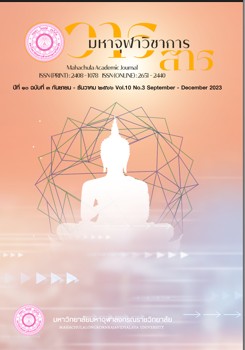Patterns of Meditation Practice and Their Application in Thai Society
Main Article Content
Abstract
The practice of meditation has long been a way of life of Thai people. Throughout the Thai history, in the period of Sukhothai, Ayutthaya, Thonburi and Rattanakosin, which altoghether ranged for 700-800 years, there has been development regarding meditation and its application in the society. This article has been studied from chronicles, stone inscriptions, archives, Tipitaka, commentary and documents related to Buddhism.
In this study it was found that during the Sukhothai period, Samatha and Vipassana meditation were practiced by Phra Aranyavasi (forest monk). They meditated to develop the mind with the goal of becoming a Buddha in the future, and the method influenced by the Lanka school. During the Ayutthaya period, there was the practice of Samatha meditation, such as Kasina, and using beads to aid meditation. The distinctive feature is that it was used to protect oneself from danger and alleviate disasters. In the Thonburi period, Vipassana meditation was practiced as a tool to anchor the mind, meditation was for solving mental problems. In early Rattanakosin period, meditation was used to develop the mind. In middle Rattanakosin period (King Rama 4 – King Rama 5), meditation was utilised to boost unity among people within the nation and to promote nationalism. The reigns of King Rama 6-8, it was a period of development of the Dhammayut school of Vipassanadhura to develop the mind until it became widespread in the Northeast region of Thailand. In modern days since the reign of King Rama IX to the present, meditation has developed into many forms, of which five forms are the majority, they are namely: Buddho, Sammā-araham, breathing (Anapanasati), rising-falling and Rūpaṇam meditation. Meditation method become widely spreaded with the advancement of technology. It is made more easily accessible, and the Thai society is open and keen to know and learn. Nowadays meditation is applied to many aspects, such as prevention of mental illness, relieving mental stress, developing the mind and at the same time retaining the original goal of reaching Nirvana. In the past and present, although there are different forms of meditation practice, the aim is the same: to follow the principles of mindfulness meditation as illuminated in the Tipitaka, while sharing the same ultimate goal, which is Nirvana.
Article Details

This work is licensed under a Creative Commons Attribution-NonCommercial-NoDerivatives 4.0 International License.
References
กรมศิลปากร. คำให้การชาวกรุงเก่า คำให้การขุนหลวงหาวัด และพระราชพงศาวดารกรุงเก่า ฉบับหลวงประเสริฐอักษรนิติ์. กรุงเทพมหานคร: รุ่งเรืองธรรม, ๒๕๑๐.
______. วรรณกรรมสมัยรัตนโกสินทร์ เล่ม ๓. กรุงเทพมหานคร: โรงพิมพ์ดอกเบี้ย, ๒๕๔๔.
กระทรวงศึกษาธิการ กระทรวงธรรมาการ. พระราชพงษาวดาร เล่ม ๒ ฉบับพิมพ์ ร.ศ. ๑๒๐. นนทบุรี: มติชนปากเกร็ด, ๒๕๕๐.
______. พระราชพงษาวดาร เล่ม ๓ ฉบับพิมพ์ ร.ศ. ๑๒๐. นนทบุรี: มติชนปากเกร็ด, ๒๕๕๐.
ปรีดี พิศภูมิวิถี. สยามศึกษาในสายตาฝรั่ง. กรุงเทพมหานคร: จุฬาลงกรณ์มหาวิทยาลัย, ๒๕๖๑.
พระกวีวรญาณ (จำนงค์ ทองประเสริฐ). วิชาศาสนา. กรุงเทพมหานคร: มหาจุฬาลงกรณราชวิทยาลัย, ๒๕๕๖.
พระมหายงยุทธ พลมั่น, พระมหาบุญเกิด ปญฺญาปวุฑฺฒี, คงสฤษฎ์ แพงทรัพย์, พระมหาพิทักษ์ จิตฺตโสภโณ. “การปฏิบัติกรรมฐานตามแนวพระมหาเถรศรีศรัทธา”. วารสารพุทธศาสตร์ปริทรรศน์ มจร. ปีที่ ๖ ฉบับที่ ๓ (กันยายน - ธันวาคม ๒๕๖๕) : ๒๔๘ - ๒๖๑.
พระมหายุทธนา นรเชฏฺโฐ. พระสงฆ์กับสังคมไทยในสมัยอยุธยา. กรุงเทพมหานคร: สหธรรมิกจำกัด, ๒๕๕๗.
พระราชพงศาวดารกรุงศรีอยุธยา(ฉบับหมอบรัดเล). กรุงเทพมหานคร: โฆษิต, ๒๕๔๙.
ภัทรพร สิริกาญจน. พระพุทธศาสนาในประเทศไทย: เอกภาพบนความหลากหลาย. กรุงเทพมหานคร: มหาวิทยาลัยธรรมศาสตร์, ๒๕๕๗.
มหาจุฬาลงกรณราชวิทยาลัย. พระไตรปิฎกภาษาไทย ฉบับมหาจุฬาลงกรณราชวิทยาลัย. กรุงเทพมหานคร: โรงพิมพ์มหาจุฬาลงกรณราชวิทยาลัย, ๒๕๓๙.
มหาวิทยาลัยมหาจุฬาลงกรณราชวิทยาลัย. อรรถกถาภาษาไทย ฉบับมหาวิทยาลัยมหาจุฬาลงกรณราชวิทยาลัย สมันตปาสาทิกา ภาค ๑. กรุงเทพมหานคร: มหาจุฬาลงกรณราชวิทยาลัย, ๒๕๕๒.
ลาลูแบร์. ซิมอน เดอ. จดหมายเหตุลาลูแบร์ ราชอาณาจักรสยาม. นนทบุรี: ศรีปัญญา, ๒๕๔๘.
วัชระ งามจิตรเจริญ. พุทธศาสนาเถรวาท. กรุงเทพมหานคร: มหาวิทยาลัยธรรมศาสตร์, ๒๕๖๑.
ศิลปวัฒนธรรม. ประวัติศาสตร์เบ็ดเตล็ด รวมบทนิพนธ์เสาหลักทางวิชาการของศาสตราจารย์ ดร.ประเสริฐ ณ นคร. กรุงเทพมหานคร: มติชน, ๒๕๔๙.
สำนักพิมพ์จดหมายเหตุ. คำให้การของชาวกรุงเก่า. นนทบุรี: สำนักพิมพ์จดหมายเหตุ, ๒๕๔๔.
สำนักงานกองทุนสนับสนุนการวิจัย. ๑๐๐ เอกสารสำคัญ สรรพสาระประวัติศาสตร์ไทย ลำดับที่ ๑. กรุงเทพมหานคร: ศักดิโสภาการพิมพ์, ๒๕๕๒.
สมเด็จพระพุทธโฆษาจารย์ (ป. อ. ปยุตฺโต). พระพุทธศาสนาในอาเซีย. กรุงเทพมหานคร: ผลิธัมม์, ๒๕๖๒.
สมเด็จพระมหาสมณเจ้า กรมพระยาวชิรญาณวโรรส. รายงานพระสงฆ์จัดการศึกษาหัวเมือง เล่ม ๑. พิมพ์ครั้งที่ ๑. กรุงเทพมหานคร: มหามกุฏราชวิทยาลัย, ๒๕๖๓.
______. รายงานพระสงฆ์จัดการศึกษาหัวเมือง เล่ม ๒. พิมพ์ครั้งที่ ๑. กรุงเทพมหานคร: มหามกุฏราชวิทยาลัย, ๒๕๖๓.
สุเชาว์ พลอยชุม. สํานักวิปัสสนาสายพระอาจารย์ มั่น ภูริทตฺโต. รายงานวิจัย. สถาบันวิจัยพุทธศาสน์ศึกษา. ศูนย์พุทธศาสนศึกษา: จุฬาลงกรณ์มหาวิทยาลัย, ๒๕๔๙.
สุภาพรรณ ณ บางช้าง. วิวัฒนาการงานเขียนภาษาบาลีในประเทศไทย: จารึก ตำนาน พงศาวดารสาส์น ประกาศ. กรุงเทพมหานคร: มูลนิธิมหามกุฏราชวิทยาลัย, ๒๕๒๙.
เสถียร โพธินันทะ. ประวัติศาสตร์พระพุทธศาสนา ฉบับมุปาฐะ. กรุงเทพมหานคร: มหามกุฏราชวิทยาลัย, ๒๕๖๕.
Kong Meng San Phor Kark See Monastery. Buddhism for Beginners. Singapore: Fabulous Printers Pte Ltd, 2016.
Somdet Phra Buddhaghosacharya. Thai Buddhism in the Buddhist World. Thailand : Cover Creative Co., Ltd., 2017.
T. W. RHYS DAVIDS. Buddhist India. New York: the Kinckerbocker press, 1903.
พระเทพวัชรบัณฑิต. กรรมฐานในพระพุทธศาสนา: บทเรียนจากมหาสติปัฏฐานสูตรและความนิยมในสังคมไทย. [ออนไลน์]. แหล่งที่มา: https://www.mcu.ac.th/article/detail/๓๕๓๙๑, [๕ พฤษภาคม ๒๕๖๔].


